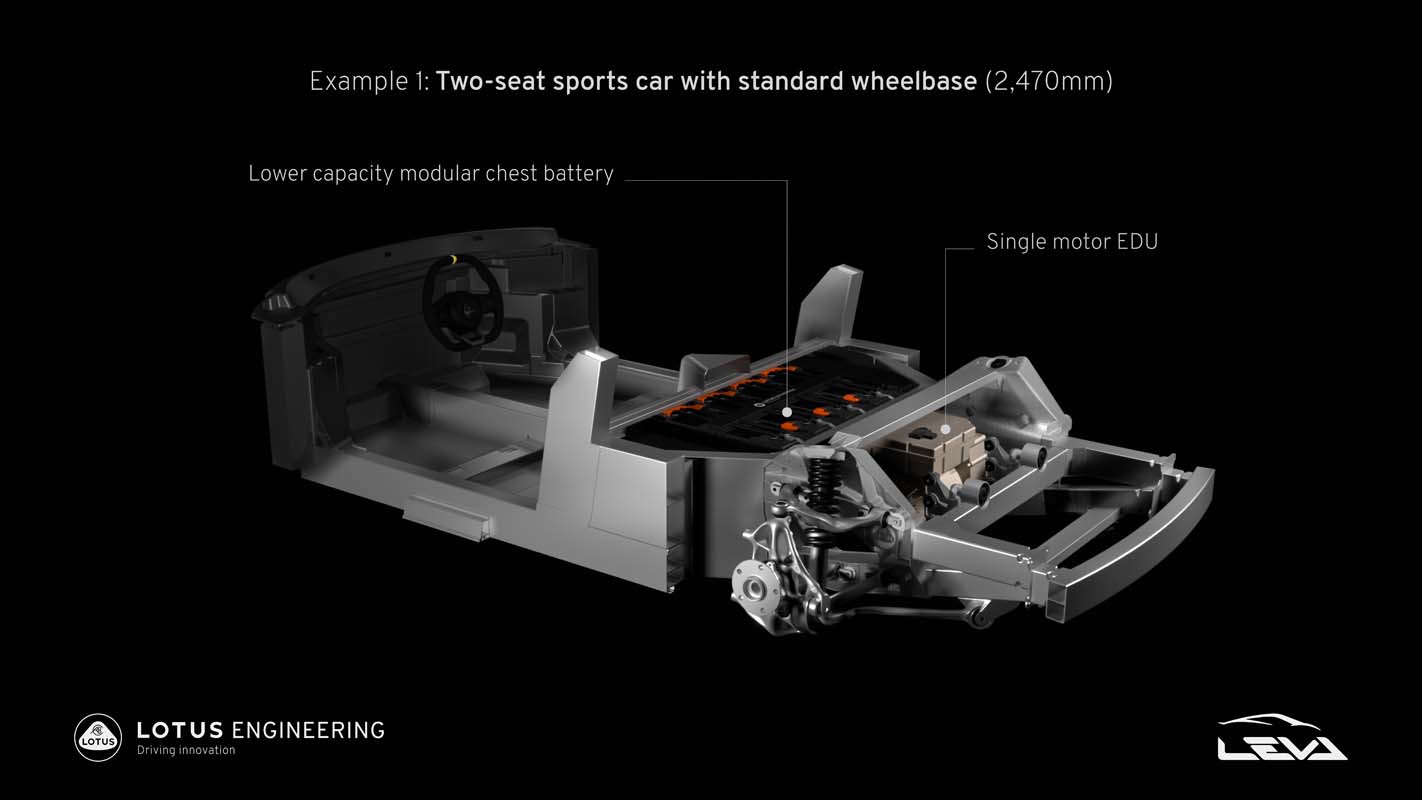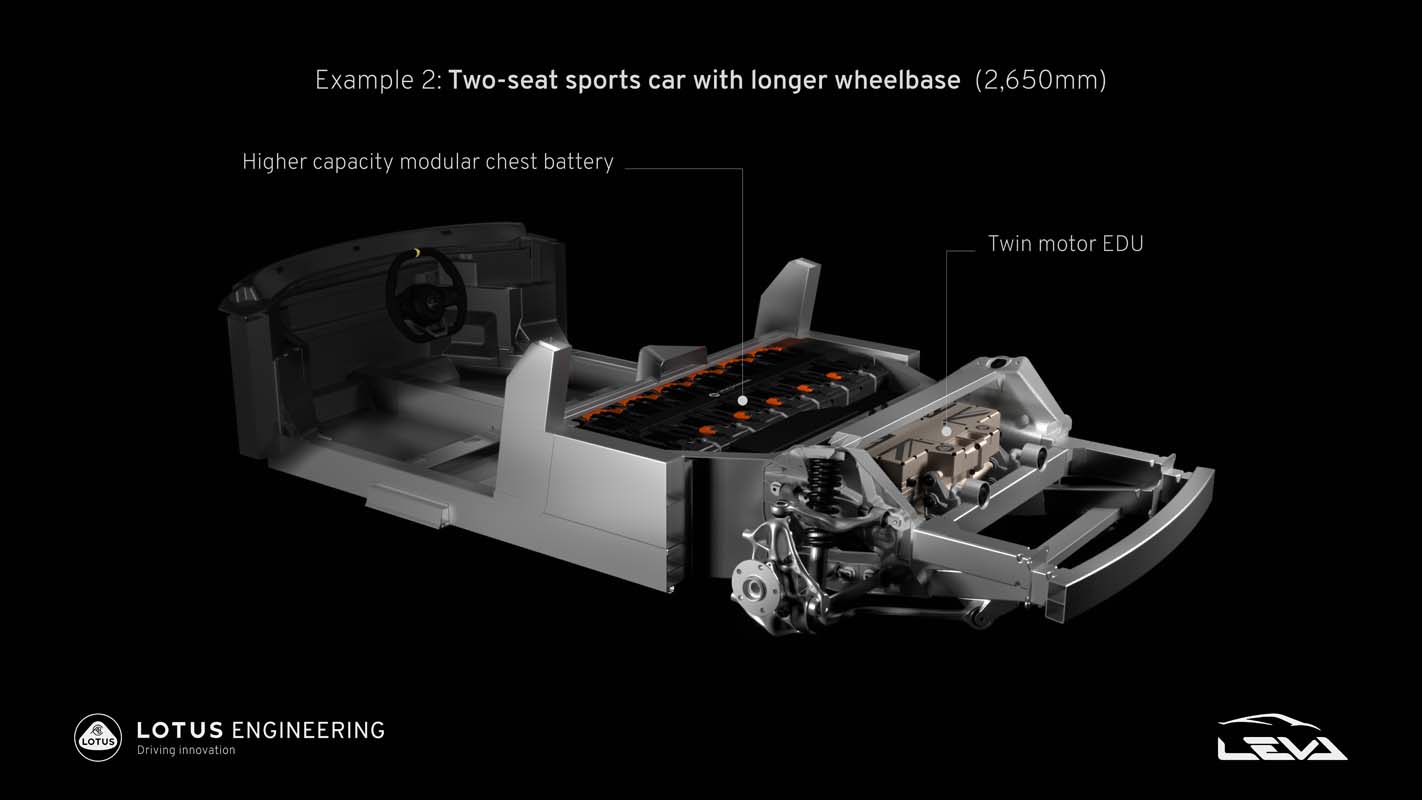
Just weeks after Lotus confirmed it will be launching a new family of EV performance cars, it has given a world premiere to the innovative new lightweight chassis technology that will underpin the electric sports car in the range.
The new structure has been developed through Project LEVA (Lightweight Electric Vehicle Architecture), announced last October by Lotus. Project LEVA is a research programme that’s accelerating the development of all-new lightweight structures for next-generation battery electric vehicles.
Today Lotus can reveal it’s this structure developed through Project LEVA which will be integrated into the company’s new architecture for electric sports cars. Thanks to the innovation of Lotus and the Project LEVA partners, the rear subframe is 37% lighter than it is on the Lotus Emira V6. It means Lotus now has the ‘blueprint’ for the next generation of electric sports cars, for future Lotus products and for the Lotus Engineering consultancy to commercialise.
The Project LEVA lightweight chassis technology is being shown at the Low Carbon Vehicle event staged by Cenex, the UK’s Low Carbon and Fuel Cells Centre of Excellence, at Millbrook Proving Ground, Bedfordshire, UK, on 22/23 September.
A new animation from Lotus reveals how the technology will form part of the new electric sports car chassis, illustrating the versatile nature of this all-new Lotus-developed vehicle architecture. It is fully adaptable to provide a platform for a range of EVs with variable layouts, wheelbase lengths, battery sizes and configurations.
|
VEHICLE LAYOUT
|
WHEELBASE
|
BATTERY SIZE / CONFIGURATION
|
MAXIMUM BATTERY POWER
|
EDU LAYOUT / MAX POWER
|
|
Two-seater
|
Minimum of 2,470mm
|
8-module / chest
|
66.4kWh
|
Single / 350kW
|
|
Two-seater
|
More than 2,650mm
|
12-module / chest
|
99.6kWh
|
Twin / 650kW
|
|
2+2
|
More than 2,650mm
|
8-module / slab
|
66.4kWh
|
Single / 350 kW or Twin / 650kW
|
As the animation shows, all three layouts feature a common lightweight die-cast rear sub-frame with multiple interchangeable components. This is the Project LEVA innovation, and it means a single vehicle architecture can accommodate two different types of battery configurations:
- ‘Chest’ layout, where the modules are stacked vertically behind the two seats. A chest layout is a ‘mid-mounted power pack’, ideal for sports car / hypercar vehicle types where a low overall ride height and low centre of gravity are required, and as seen on the Lotus Evija pure electric hypercar.
- ‘Slab’ layout, where the modules are integrated horizontally under the cabin. This is most suitable for vehicles where a higher ride height and a taller overall profile is required. It is often referred to as a ‘skateboard power pack’ layout.
The innovative new subframe features cylindrical battery cells for high energy density, with the option of a single or twin electronic drive unit (EDU) to support. Cold cure, spot bonding and advanced weld processes mean reduced environmental impact during assembly.
This unique degree of flexibility and modularity in wheelbase and propulsion solutions will be the genesis for a wide variety of electric vehicle applications. These could be for the eagerly anticipated Lotus electric sports car – scheduled for launch in 2026 – as well as for third-party clients through Lotus Engineering.
Funding for the project came in part from the Advanced Route to Market Demonstrator programme (ARMD). Awarded by the UK Government’s Department for Business, Energy and Industrial Strategy (BEIS), the programme is delivered on behalf of the Advanced Propulsion Centre (APC) by Cenex.
Richard Moore, Executive Director, Engineering, Lotus Cars, commented: “Project LEVA and the electric sports car architecture are perfect illustrations of the innovation which continues to be at the heart of everything Lotus does. Today’s EVs are heavy in comparison to their ICE equivalents, so the ARMD funding has helped Lotus to innovate earlier in the product cycle and develop a new vehicle architecture that targets lightweight and performance density from conception. Rather than developing a single vehicle, it means Lotus now has the ‘blueprint’ for the next generation of electric sports cars, for future Lotus products and for the Lotus Engineering consultancy to commercialise.”
Project LEVA has been led by engineer Richard Rackham, Head of Vehicle Concepts, Lotus. Richard is best known for his revolutionary work on development of the extruded aluminium Lotus Elise architecture 25 years ago. Richard commented: “Project LEVA is as revolutionary now as the Elise architecture was in 1996. In true Lotus spirit, significant weight savings have been achieved throughout, with a focus on ultimate performance, efficiency and safety being engineered into the structure from the outset – for example, by utilising the vehicle structure as the battery enclosure, having an integrated EDU, eliminating subframes and optimising the multi-link suspension components.”
On Project LEVA, Lotus has collaborated with supply chain partner Sarginsons Industries and leading academics from Brunel University London to harness the full ‘light-weighting’ potential of the vehicle architecture.
Today’s announcement is the latest in a series detailing Lotus’ transition to an all-electric brand:
- January 2021: Lotus announced it had signed a Memorandum of Understanding with Alpine, the performance car division of Groupe Renault, to study a number of areas of cooperation, including the joint development of an EV sports car.
- April 2021: at the Driving Tomorrow global strategy conference, Lotus confirmed the E-Eports vehicle architecture was one of four Lotus-developed chassis that would underpin future models.
- August 2021: Lotus confirmed it would be launching a new electric sports car in 2026 – Type 135 – which is intended to be manufactured in the UK.
- Today: Lotus gives a world premiere to the innovative new chassis technology that will underpin that electric sports car.
The next stage of the project is for Lotus to continue development of the all-electric vehicles which will be built on this innovative and market leading new architecture.
Also on the Lotus stand at Cenex is the Lotus Evija, the world’s first pure-electric British hypercar. The car, an engineering prototype, will be ‘naked’ with several body panels removed to allow visitors to see key components and systems.

